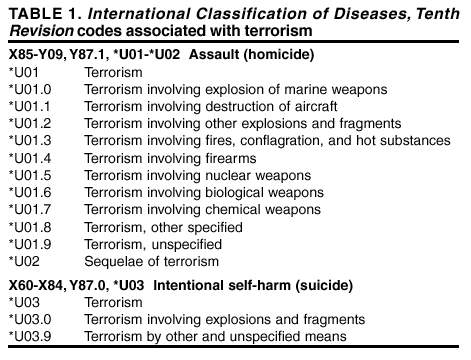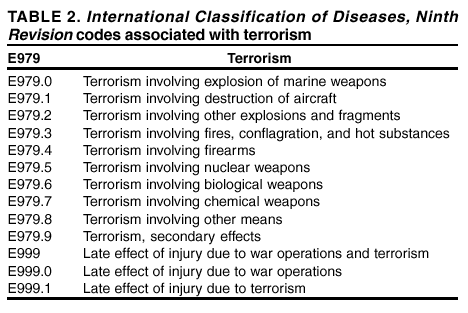 |
|
|
|
|
|
|
| ||||||||||
|
|
|
|
|
|
|
||||
| ||||||||||
|
|
|
|
|
Persons using assistive technology might not be able to fully access information in this file. For assistance, please send e-mail to: mmwrq@cdc.gov. Type 508 Accommodation and the title of the report in the subject line of e-mail. Notice to Readers: New Classification for Deaths and Injuries Involving TerrorismClassification of the deaths and injuries that occurred as the result of the events of September 11, 2001, presented CDC's National Center for Health Statistics (NCHS) with a dilemma. Under the current classification systems for mortality and morbidity, the World Health Organization's International Classification of Diseases, Tenth Revision (ICD-10) and the United States' International Classification of Diseases, Ninth Revision, Clinical Modification (ICD-9-CM), deaths and injuries associated with acts of terrorism could not be identified uniquely. To evaluate the adequacy of the classification systems for characterizing terrorism-related deaths and injuries and in response to requests from the affected states for guidance in classifying these events, NCHS formed an Ad Hoc Workgroup on the Classification of Death and Injury Resulting from Terrorism. The recommendations of the workgroup and consultations with other federal and nonfederal partners resulted in the development by NCHS of a new set of codes within the framework of ICD-10 and ICD-9-CM and a set of guidelines that will allow the classification of deaths and injuries associated with terrorism (1). For mortality, the codes developed include *U01-*U02 for terrorism involving an assault (homicide) and *U03 for terrorism involving intentional self-harm (suicide) (Table 1). Additional information about the structure of the mortality codes and inclusion terms is available at http://www.cdc.gov/nchs/about/otheract/icd9/appendix1.htm. The asterisk preceding each code indicates that the code was introduced by the United States but is not officially part of the ICD. Codes from the "U" Chapter of ICD-10 were selected because this chapter was reserved specifically for "future additions and changes and for possible interim classifications to solve difficulties arising at the national and international levels between revisions" (2). To maintain international comparability in reporting homicide and suicide rates, deaths coded to *U01-*U02 will be included in general tabulations with other homicides (X85-Y09 and Y87.1), and deaths coded to *U03 will be included with other suicides (X60-X84 and Y87.0). Implementation of the codes developed for mortality classification is effective with 2001 mortality data. For injuries associated with terrorism not resulting in death, the codes developed include E979 and E999.1 (Table 2). E979 was unused previously in ICD-9-CM; E999, which was used previously to denote the late effects of war operations, was modified to include late effects of terrorism. E999.0 was created to classify the late effects of war operations, and E999.1 was created for late effects of terrorism. Additional information about the structure of the morbidity codes and inclusion terms is available at http://www.cdc.gov/nchs/about/otheract/icd9/appendix1.htm. For statistical purposes, codes E979 and E999.1 will be tabulated with other assaults (E960-E969). No plans exist to create a parallel category for self-inflicted injury. Implementation of the codes developed for morbidity will be effective October 1, 2002. For the new terrorism codes to be used for the classification of deaths and injuries, the incident in question must be designated as a terrorist act by the U.S. Federal Bureau of Investigation (FBI), which has jurisdiction over the investigation and tracking of terrorism in the United States. The FBI defines a terrorism-related injury as one resulting from the " unlawful use of force or violence against persons or property to intimidate or coerce a government, the civilian population, or any segment thereof, in furtherance of political or social objectives" (3). This precludes individual judgments made by medical examiners, coroners, medical coders, nosologists, or hospital staff. If the incident is labeled as a terrorist act before the completion of the death certificate or the filing of the medical record, it may be so described on the certificate or discharge record. When the incident is labeled as terrorism after the death certificate has been filed, the certificate can be recoded. Updating and recoding of the medical record after it is completed and submitted for reimbursement is more complicated and is unlikely to occur. The standardized classification systems described here address the need to identify deaths and injuries resulting from terrorism and will allow a better assessment of the public health impact of terrorism in the United States. References
Table 1  Return to top. Table 2  Return to top.
Disclaimer All MMWR HTML versions of articles are electronic conversions from ASCII text into HTML. This conversion may have resulted in character translation or format errors in the HTML version. Users should not rely on this HTML document, but are referred to the electronic PDF version and/or the original MMWR paper copy for the official text, figures, and tables. An original paper copy of this issue can be obtained from the Superintendent of Documents, U.S. Government Printing Office (GPO), Washington, DC 20402-9371; telephone: (202) 512-1800. Contact GPO for current prices. **Questions or messages regarding errors in formatting should be addressed to mmwrq@cdc.gov.Page converted: 9/9/2002 |
|||||||||
This page last reviewed 9/9/2002
|